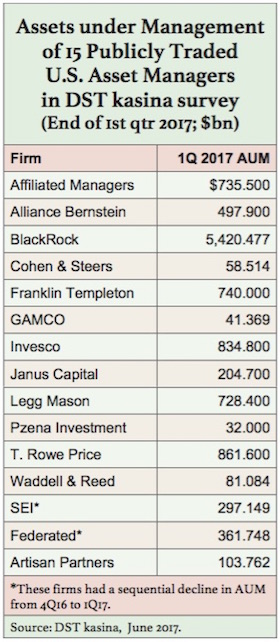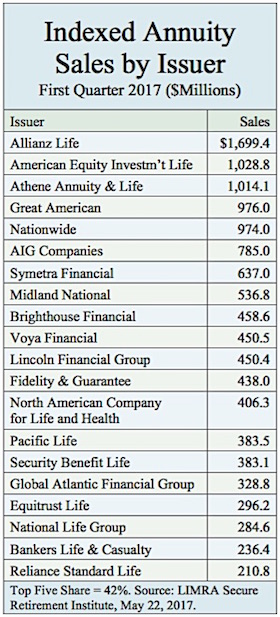Seven in 10 large plans report “leakage” as a problem or concern
In a new study, “HR Perspectives: A Survey of Larger 401(k) Plans,” T. Rowe Price reports the results of a survey of human resource and benefits managers administering plans with assets of $100 million or more.
The survey, which took place in late 2016 and drew on telephone and online responses from 269 executives, found that plan sponsors are “taking steps to offer a number of automatic programs, matching contributions, stretch matches, and more to drive successful retirement outcomes.”
Among the survey findings:
- 41% of plan sponsors say helping retirees manage income from their 401(k) is a major strategic goal for their plan.
- Almost half (48%) of plan sponsors say they have a formal metric to track the retirement preparedness of their employees. Those offering a metric report higher use of auto-escalation (used by 63% of those with a metric versus 52% of those without), and periodic enrollment of non-participating employees (used by 55% with a metric versus 41% without).
- 52% of the 48% who use a formal metric say the metric was provided by their recordkeeper; 25% report using a proprietary metric that their company developed independently; 21% sourced the metric from a consultant or adviser.
- Almost two-thirds (64%) “feel better” about 401(k) participant retirement preparedness compared with two years ago.
- 64% ranked “enabling employees to retire at their preferred retirement date” as one of their major 401(k) plan goals, making it the third highest-ranked goal.
- 89% of plan sponsors offer matching contributions.
- 51% of the 89% offer a traditional matching formula and 38% offer a “stretch match” (the more you contribute, the larger the match) to encourage higher contribution rates.
- 83% of plan sponsors offer target date funds (TDFs)
- 96% to 98% are satisfied with the various types of target date funds; 60% are very satisfied.
- 88% of plan sponsors that offer target date funds use them as a qualified default investment alternative (QDIA).
- About half of plan sponsors that offer target date funds report using their recordkeepers’ proprietary funds.
- 70% say that leakage of retirement plan assets (due to defaults on plan loans, hardship withdrawals, and cash-outs) is a major or minor problem for their plans.
- Plans that have a leakage problem are offering financial wellness programs (but not individual financial counseling), education about the potential effect of leakage on savings goals, or debt management tools and services.
American College goes global with education offerings
The American College of Financial Services and GAMA International are partnering to develop two streamlined credentials for international markets: a three-course skills training designation for agents and advisors and a three-course management designation for leaders. Each credential would take about a year to complete.
The College will rely on the GAMA distribution arrangement as the primary international outlet for selected College products that include the following:
- The Retirement Income Certified Professional (RICP) designation program
- The new Wealth Management Certified Professional (WMCP) program that will be launched in the US this fall and will be made available at a future date in global markets
- The Master of Science in Management (MSM) degree program in advanced executive leadership
Each of the two organizations will continue to maintain ownership of its own intellectual property and trademarks. The proposed agreement does not include any US distribution partnership and does not impact current arrangements The College has in a few selected global markets.
GAMA International is a worldwide association serving the professional development needs of more than 8,000 field leaders in the insurance, investment and financial services industry. The American College of Financial Services, founded in 1927, is the nation’s largest non-profit educational institution devoted to financial services.
The College offers such financial planning designations as the Retirement Income Certified Professional (RICP), Chartered Life Underwriter (CLU), Chartered Financial Consultant (ChFC) and education leading to the Certified Financial Planner (CFP) Certification.
Nationwide provides resources to simplify fiduciary rule
As the first phase of the Department of Labor’s (DOL) Conflict of Interest Rule goes into effect this week, the Nationwide Retirement Institute is providing resources and support to help advisors incorporate a best interest process with clients.
Starting June 9, those who give advice on investments within retirement accounts will be held to the Impartial Conduct Standards, which have three requirements:
- Advice is in the best interest of the customer
- Compensation is reasonable
- Statements about investment transactions, compensation and conflicts of interest are not misleading
The full requirements will go into effect on Jan. 1, barring further regulatory or legislative changes.
The Nationwide Retirement Institute’s DOL website provides resources for firms and advisors wrestling with the complexities of the fiduciary rule, such as identifying any new requirements as a fiduciary, taking a close look at the Best Interest Contract Exemption, understanding how the regulations may affect their business and how to address common client questions. These new tools will be available starting June 9, and will also help advisors implement a prudent process that puts clients’ interests at the center of advice-giving, simplifying complex topics like:
- Optimizing Social Security filing decisions
- Estimating health care costs in retirement
- Planning for long-term care expenses
- Understanding market dynamics
Nationwide helps advisors serve a variety of client needs, whether working in a commission-based or fee-based model. With the acquisition of Jefferson National, operating as Nationwide’s advisory solutions business, Nationwide offers resources leveraging tax-deferred investing to accumulate wealth. Financial professionals can access the educational video on Maximizing Tax Deferral, visit the Knowledge Bank, or call the Advisor Support Desk at (866) 667-0564.
Millennials are confident—overconfident—of inheriting money: Natixis
Over three-quarters (78%) of Americans say it’s up to them, not the government, to provide enough money to live in retirement, but 77% are counting on family support to help fund their retirement, according to Natixis Global Asset Management.
A nationwide-survey of 750 individual investors by Natixis found:
- Millennials are twice as likely as Boomers to think that a financial inheritance from their parents or grandparents and support from their children will be important to meeting their retirement needs
- 62% of Millennials, compared to 31% of Boomers, expect to receive an inheritance to help fund their retirement.
- 47% of Millennials, compared to 24% of Boomers, say family assistance with finances and housing will be an important part of their financial security in retirement.
- 49% of Americans, including 60% of Millennials, and 43% of Boomers, will rely on cash from the sale of their homes and/or business to finance retirement.
- 33% of Millennial couples and 35% of Boomer couples say their spouse’s retirement savings will be very important.
- 47%) of Baby Boomers and 35% of Millennials believe Social Security will be an important part of their retirement income.
- 41% of Millennials don’t expect Social Security benefits will be available by the time they retire.
- 98% of Americans agree their personal savings and investments, including workplace retirement savings and other qualified retirement plans will be essential in retirement.
- 68% of Millennials expect to receive an inheritance, but 40% of Boomers don’t plan to leave one.
- More than half of Boomers (57%) think they won’t have anything left for a legacy, and another 35% plan to spend freely on themselves before they die.
Americans were the least likely among those in the 22 countries and regions surveyed to expect to leave an inheritance. Nine in 10 Mexicans expect to leave an inheritance, but only 37% expect to receive one. Over half (53%) of Americans expect to donate part of their estate to charity, compared with a global average of 37%.
“Younger investors are starting to plan and save for retirement earlier in life, in part because of the availability of workplace retirement savings plans,” said Ed Farrington, EVP of Retirement at Natixis Global Asset Management. “Yet many are underestimating the impact of taxes, inflation and increased longevity on their retirement savings, and are overestimating the planning their parents have done.”
© 2017 RIJ Publishing LLC. All rights reserved.




 nt wit, I dove into Chapter 10, ready to discover what Schaus (right) and Gao, both of PIMCO, were telling plan sponsors about helping participants navigate the transition from accumulation to income at retirement.
nt wit, I dove into Chapter 10, ready to discover what Schaus (right) and Gao, both of PIMCO, were telling plan sponsors about helping participants navigate the transition from accumulation to income at retirement.






